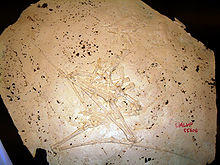| Sinopterus | |
|---|---|
 | |
| Fossil specimen, National Museum of Natural Science | |
| Scientific classification | |
| Kingdom: | Animalia |
| Phylum: | Chordata |
| Order: | †Pterosauria |
| Suborder: | †Pterodactyloidea |
| Family: | †Tapejaridae |
| Genus: | †Sinopterus Wang & Zhou, 2003 |
| Type species | |
| †Sinopterus dongi Wang & Zhou, 2003 | |
| Other species | |
| |
| Synonyms | |
| Synonyms of S. jii
Synonyms of S. atavismus
| |
Sinopterus (meaning "Chinese wing") was a genus of tapejarid pterodactyloid pterosaur from the Aptian-age Lower Cretaceous Jiufotang Formation of Chaoyang, Liaoning, China. It was first described and named by Wang Xiaolin and Zhou Zhonghe. Three species have been classified in this genus, though only two are generally considered to be valid. Sinopterus is known for its proportionally large skull, which has a birdlike pointed beak, a long bony crest that starts with a tall premaxilla and goes back along the middle of the skull to form a point overhanging the rear of the skull, and its lack of teeth.
Description and classification
The type species, S. dongi, is based on IVPP V13363, an articulated, nearly complete skeleton. The skull of this individual was 17 centimeters (6.7 inches) long, and the wingspan was estimated to be 1.2 meters (3.9 feet). The authors suggested that it was an omnivore, and noted that it was the first record of a tapejarid outside of Brazil, and the earliest and most complete tapejarid.[1]
A second species, S. gui, was named by Li, Lü, and Zhang in 2003 based on BPV-077, another nearly complete skeleton from the Jiufotang Formation. It was said to differ from S. dongi mainly in its smaller size (only about half the size of S. dongi) and the presence of a notarium,[2] though this was later disproved.[3] Some later studies found S. gui to simply represent a younger specimen of S. dongi,[4] though one large analysis in 2014 found it to be a more primitive tapejarid closely related to Nemicolopterus.[5]
A third species was referred to Sinopterus in 2007, S. jii. This species was first named by Lü & Yuan in 2005 as the type species of a new genus which they named Huaxiapterus. Two later studies in 2007 and 2011 both showed that H. jii was in fact more closely related to Sinopterus than to the two other species also assigned to Huaxiapterus, "H." corollatus and "H." benxiensis. Both groups of researchers concluded that Huaxiapterus jii should therefore be reclassified as Sinopterus jii, and that the other two species of "Huaxiapterus" require a new genus name.[3][4] However, a more complete phylogenetic analysis showed that Sinopterus may actually be an intermediate step in the grade between H. jii and the other two Huaxiapterus species, making Sinopterus paraphyletic if H. jii is included.[5]
In 2016, another species, S. lingyuanensis, was named. It differs from other species in the proportions of its nasoantorbital fenestra, its rostral index, the relative sizes of its femur and tibia, and the relative sizes of the first and second wing digits. In the same paper describing this species, the species Huaxiapterus atavismus was also named.[6] However, Xinjun Zhang and colleagues in 2019 considered Huaxiapterus an invalid genus and therefore reassigned H. atavismus to Sinopterus, which created the new combination Sinopterus atavismus.[7]
The cladogram below follows the 2014 analysis by Brian Andres and colleagues, showing the placement of two Sinopterus species ("S." gui and S. dongi) within the clade Tapejaromorpha.[5]
| Tapejaromorpha |
| ||||||||||||||||||||||||||||||||||||||||||||||||||||||||||||||||||||||||
In 2019, a different analysis, this time by Alexander Kellner and colleagues, had recovered Sinopterus within the Tapejarinae, a subfamily within the larger group Tapejaridae, sister taxon to both Eopteranodon and Huaxiapterus.[8] The cladogram of their analysis is shown below:
| Tapejaromorpha |
| ||||||||||||||||||||||||||||||||||||||||||||||||||||||||||||
See also
- List of pterosaur genera
- Timeline of pterosaur research
References
- ^ Wang, X.; Zhou, Z. (2003). "A new pterosaur (Pterodactyloidea, Tapejaridae) from the Early Cretaceous Jiufotang Formation of western Liaoning, China and its implications for biostratigraphy" (PDF). Chinese Science Bulletin. 48: 16–23. doi:10.1007/bf03183326. Archived from the original (PDF) on 2007-10-27.
- ^ Li, J.; Lü, J.; Zhang, B. (2003). "A new Lower Cretaceous sinopterid pterosaur from the Western Liaoning, China". Acta Palaeontologica Sinica. 42 (3): 442–447.
- ^ a b Kellner, A.W.A.; Campos, D.A. (2007). "Short note on the ingroup relationships of the Tapejaridae (Pterosauria, Pterodactyloidea)". Boletim do Museu Nacional. 75: 1–14.
- ^ a b Pinheiro, Felipe L.; Fortier, Daniel C.; Schultz, Cesar L.; De Andrade, José Artur F.G.; Bantim, Renan A.M. (September 2011). "New information on the pterosaur Tupandactylus imperator, with comments on the relationships of Tapejaridae". Acta Palaeontologica Polonica. 56 (3): 567–580. doi:10.4202/app.2010.0057.
- ^ a b c Andres, B.; Clark, J.; Xu, X. (2014). "The earliest pterodactyloid and the origin of the group". Current Biology. 24 (9): 1011–6. doi:10.1016/j.cub.2014.03.030. PMID 24768054.
- ^ Lü, Junchang; Teng, Fangfang; Sun, Deyu; Shen, Caizhi; Li, Guoqing; Gao, Xia; Liu, Hanfeng (2016). "The toothless pterosaurs from China". Acta Geologica Sinica. 90 (9): 2513–2525.
- ^ Zhang, X.; Jiang, S.; Cheng, X.; Wang, X. (2019). "New Material of Sinopterus (Pterosauria, Tapejaridae) from the Early Cretaceous Jehol Biota of China". Anais da Academia Brasileira de Ciências. 91: 2.
- ^ Kellner, Alexander W. A.; Weinschütz, Luiz C.; Holgado, Borja; Bantim, Renan A. M.; Sayão, Juliana M. (19 August 2019). "A new toothless pterosaur (Pterodactyloidea) from Southern Brazil with insights into the paleoecology of a Cretaceous desert". Anais da Academia Brasileira de Ciências. 91 (suppl 2): e20190768. doi:10.1590/0001-3765201920190768. ISSN 0001-3765. PMID 31432888.
